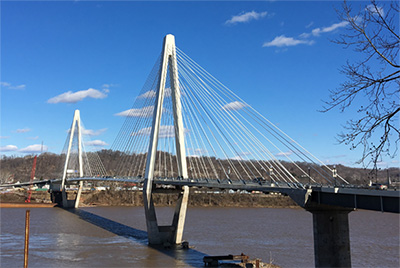Connect with ASBI

9901 Brodie Lane, Suite 160 PMB 516 • Austin, TX 78748
Phone: 512.523.8214
Copyright © 2023 American Segmental Bridge Institute
Segmental bridge construction offers the advantages of repetitive construction procedures, minimum impact to traffic and the environment during construction, economical construction, and a durable structure.
Segmental construction can be used in a variety of difficult site conditions. Piers can be placed on small footprints, superstructures can go over natural hazards and community landmarks, and segmental bridges may be used on a small radius such as curved highway access ramps, as well as large-radius bridges.
Their slender piers and long, shallow superstructures make concrete segmental bridges aesthetically pleasing, and the concrete can be colored to blend into the environment.
ASBI Design and Construction of Concrete Segmental Bridges 101 Booklet
Segmental bridge construction offers the advantages of repetitive construction procedures, minimum impact to traffic and the environment during construction, economical construction, and a durable structure.
Segmental construction can be used in a variety of difficult site conditions. Piers can be placed on small footprints, superstructures can go over natural hazards and community landmarks, and segmental bridges may be used on a small radius such as curved highway access ramps, as well as large-radius bridges.
Their slender piers and long, shallow superstructures make concrete segmental bridges aesthetically pleasing, and the concrete can be colored to blend into the environment.
The use of precast concrete segments has the advantage that the superstructure can be erected at a faster rate compared to cast-in-place construction. Precast concrete segments are built using either a short-line or long-line method while the substructure is being built.
Precast segments are usually erected using one of three methods:
1. Span-by-Span: In the span-by-span method, an entire span is assembled, post-tensioned and erected so that it is self-supporting before the next span is erected. The method is appropriate for span lengths up to about 150 feet.
2. Balanced Cantilever: In this method, the superstructure is erected by cantilevering out from opposite sides of the pier. The segments are added either at the same time or alternately to each cantilever to maintain a relatively balanced system. The balanced cantilever method is most economical for span lengths between about 160 and 500 feet.
3. Progressive Placement: This method involves starting at one end of the bridge and erecting segments in sequential order. This is particularly suitable for environmentally sensitive areas or where construction access is limited. Progressive placement usually requires the placement of temporary piers at the middle of each span and is suitable for span lengths of 100 to 300 feet.
Cast-in-place segmentally constructed bridges are built using the balanced cantilever method. A form traveler is used at the end of each cantilever to support the formwork and new concrete segment prior to post-tensioning. This type of construction is used when the precast segments are too heavy to be transported. It has been used for span lengths up to 760 feet in the U.S.
 A cable-stayed bridge is a segmental bridge in which the superstructure is supported by inclined cables extending from a pylon above the deck. This type of structure provides economic and aesthetically pleasing solutions for bridge spans from 300 to 2,500 feet.
A cable-stayed bridge is a segmental bridge in which the superstructure is supported by inclined cables extending from a pylon above the deck. This type of structure provides economic and aesthetically pleasing solutions for bridge spans from 300 to 2,500 feet.
The cables are generally arranged in one of three configurations:
1. Harp – The inclined cables are parallel.
2. Fan – The inclined cables emerge from a point near the top of the pylon.
3. Semi-fan – The inclined cables emerge over a vertical length near the top of the pylon.
Each of these configurations may be combined with a central cable plane or twin edge cable planes. Usually, the edge girder system is used with twin cable planes, whereas a single cable plane requires the torsionally rigid cross section of the box. These factors influence both the visual appearance of the bridge and its structural design.
Extradosed bridges are similar in appearance to cable-stayed bridges but have shorter pylons and a flatter stay-cable inclination. As such, the deck system becomes the primary load carrying member for dead and live loads. This type of bridge is a hybrid of a cable-stayed bridge and a post-tensioned box girder bridge. The bridges are constructed in a similar manner as cable-stayed bridges and are useful where there are restrictions on the height of the pylon.
Concrete arches may be constructed segmentally using either precast or cast-in-place segments. The arch is erected by cantilevering out from the base of the arch. Temporary inclined cables are used to support the arch until the two halves meet and at that point, the arch is self supporting and the cables are removed. This type of construction allows the arch to be built without any interference on the ground below. As such, segmental arches may be used to span environmentally sensitive areas and deep gorges.
Segmental methods may also be used for the construction of concrete columns for bridges. The method is similar to that for precast segmental superstructures using the short-line method of casting except the match casting is done vertically and not horizontally. During erection, the segments are stacked vertically on top of each other and incrementally post-tensioned. The primary advantage of using segmental columns is speed of erection.